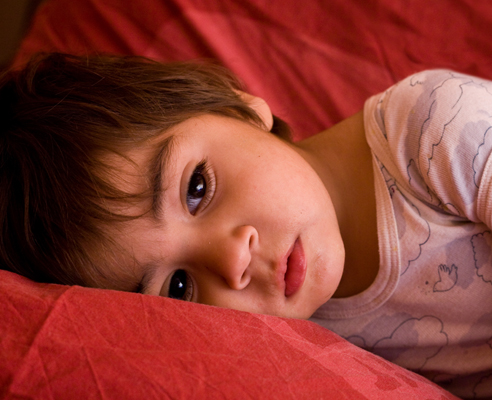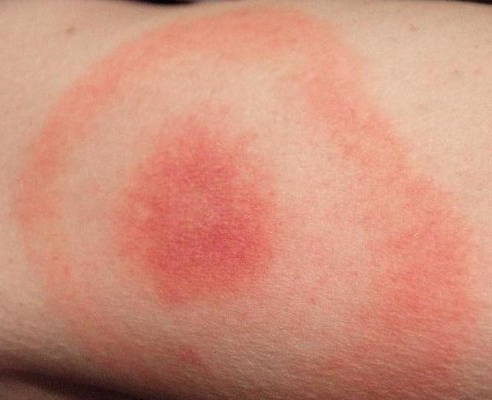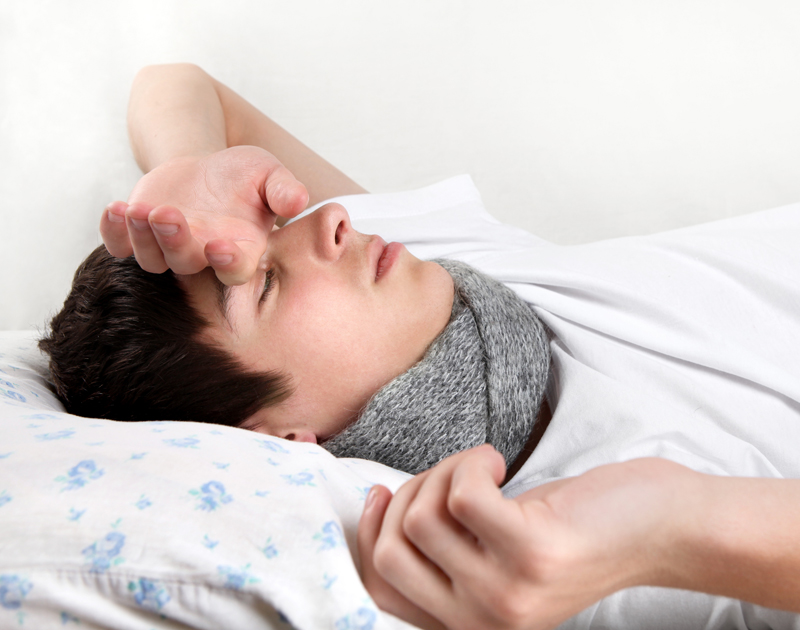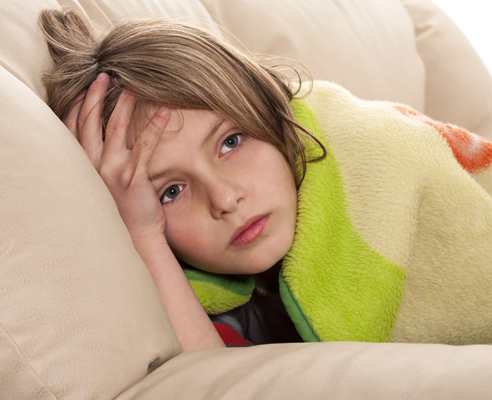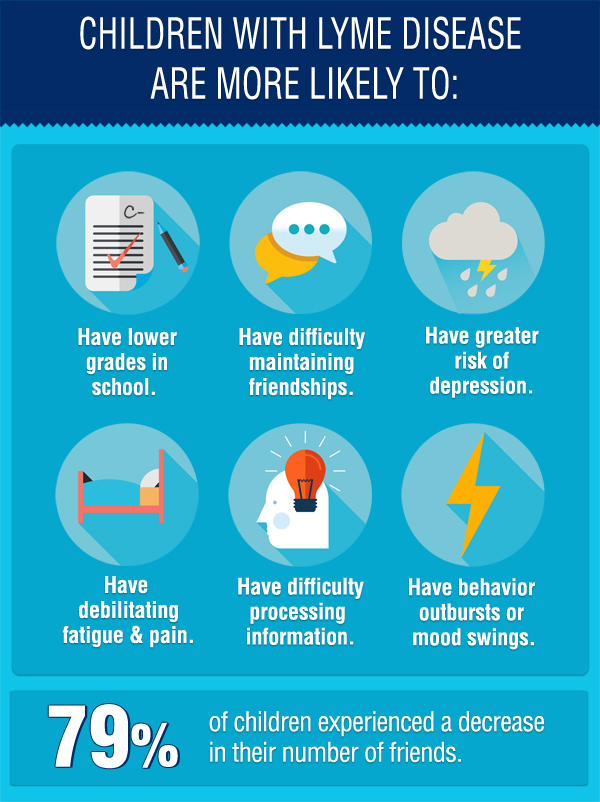-
Lyme disease can affect almost any part of the body, including the central and peripheral nervous system, heart, brain, muscles, joints, skin, and eyes.
Multiple symptoms with migratory joint pain that comes and goes is the hallmark of Lyme disease. Symptoms can appear soon after the infection or may not present until months or even years later.
In the early stage of the disease, patients typically experience flu-like symptoms including, fatigue, headaches, fevers, chills, body aches and pains, and gastrointestinal problems. There may also be objective signs of the disease present, such as Bell’s Palsy (drooping on one half of the face) or the appearance of a erythema migrans (EM or bull’s-eye) rash. The EM rash is a clear indication of Lyme disease.
-
-
Facts about the bulls-eye rash
- There may be one single rash at the site of the known tick bite or multiple rashes, which indicates the Lyme bacteria is disseminating to other parts of the body.
- The area of the bite is usually not itchy and should not be confused with a spider bite.
- The rash usually appears within the first week but it can take up to 30 days.
- The rash may appear on any area of the body, it is not always at the site of a known tick bite. It may also be hidden under the hair, on the scalp or in the perianal area. Studies have found that children are more likely to have a tick bite in the neck and head region.
The number of patients who have an EM rash has been disputed. Studies have found the EM rash is absent in more than 50% of Lyme disease cases. (The CDC reports the rash is present in 70% – 80% of cases.) Dr. Charles Ray Jones has found that according to his clinical experience, only 7% of the pediatric patients report having an EM rash, while secondary EM rashes are reported in 3% to 5% of his patients. These rashes are temporary and can be seen one minute but disappear the next.
Bottom line: Your child can have Lyme disease and not have the bull’s-eye rash.
Lyme disease, which can cause a wide range of physical, psychiatric and cognitive symptoms, can be particularly difficult to identify in children and adolescents. It’s difficult for young children to describe how they’re feeling, especially with a disease where symptoms are waxing and waning and changing over time. Parents may have difficulty recognizing symptoms when their child is young and there’s no medical baseline to compare with. And lastly, puberty and developmental stages may be blamed for sudden changes in the child’s behaviors and personality.
-
Lyme Disease Symptoms Overview
Dr. Charles Ray Jones describes some of the most common symptoms he has seen in his 40-plus years of clinical experience treating more than 15,000 pediatric patients suffering from Lyme disease and associated tick-transmitted illnesses.
-
Dr. Charles Ray Jones shares his clinical observations in treating more than 15,000 pediatric patients for Lyme disease over the past 40 years.
-
- Fatigue. This symptom is universal in children with Lyme disease. Fatigue can be intermittent or ongoing. Or a child may suddenly have poor stamina, unable to perform physical activities they once enjoyed. A child can be energetic and then collapse or ‘wilt’ from exhaustion, or they can be completely bedridden with fatigue.
For example: A 4-year-old patient would run on the playground with other kids but needed to sit down after only a few minutes. This patient wasn’t sleeping all day but, he did not have the stamina that a healthy 4-year-old should have.
Another 14-year-old patient experienced fatigue so extreme that spending a few hours out with his friends after school would land him in bed for several days just recuperating.
- Joint pain. Migratory joint pain is a hallmark of Lyme disease. The pain can travel between different joints or the intensity of pain may vary for the affected joints. Typically more than one joint is involved. Larger joints are usually impacted, including the knees, hips, shoulders, and elbows. The knee joints may be painful but do not have to be swollen. Pain can also occur in smaller joints, like the fingers, wrists, hands, ankles and feet. There may also be pain in the child’s neck and back.
A young child can have difficulty describing their pain. Continuously rubbing and massaging an affected joint may be an indication that the child is having joint pain. The pain can also stop a child from doing a particular activity.
For example: A patient would become oppositional when asked to cross his legs while sitting on the floor during reading hour in his Pre-K class. The teacher complained to the parents. When questioned, the patient explained that his knees felt better when his legs were straight.
- Muscle pain and weakness. Muscle pain is often generalized and usually does not have a trigger point location. Children may have morning stiffness, and muscle weakness that will impact their ability to play sports or physical activities. They may experience muscle stiffness and pain in their neck and upper back. Some patients are unable to walk or stand due to muscle weakness.
For example: Some children are unable to walk or stand due to extreme muscle weakness. One young patient had difficulty walking. The parents were told their child needed to see a psychiatrist. I diagnosed him with Lyme disease. He was treated and today is running around with his other siblings.
- Migraine and non-migraine headaches. Young children often describe their headaches as a general soreness or pressure on their head.
For example: Young patients have described headaches by saying their “hair hurts” or by holding their head. Some patients will gently press their head up against an object or person, trying to relieve the pain.
- Fevers and night sweats. Fevers are usually low grade and can be associated with chills. A low-grade fever for a young child can be anywhere between 99ºF and 101ºF.
- Sleep disturbances. A child may be sleeping too much or they may have difficulty falling asleep. They may have night terrors, bedtime fears and anxiety.
- Gastrointestinal pain. Stomach pain, including nausea and other digestive issues, may be present.
- Urinary problems. A child may have pain when urinating or urinate more frequently. They may develop urinary incontinence.
- Irritability and impulsivity. Children may have a low frustration tolerance and difficulty focusing. School work can suffer.
For example: Patients have been misdiagnosed with attention deficit hyperactivity disorder (ADHD) or oppositional defiant disorder (ODD). When treated appropriately with antibiotics these behaviors disappeared.
- Mood swings, emotional liability. Children may exhibit uncharacteristic and/or abrupt personality changes. They may appear depressed or anxious.
- Obsessive compulsive behaviors. OCD-type behaviors may be present. Compulsions might be hard to recognize in toddlers and young children. Compulsions can be subtle.
For example: A patient may have a compulsion with chewing or touching things. Turning on and off light switches, continuously touching objects around them.
A 3-year-old patient would chew on his shirt collar incessantly but the mother didn’t recognize something was wrong until he chewed a hole through a young girl’s stockings while they were resting during nap time.
- Bursts of aggression/rage. Parents will say their child changed overnight and became a different kid. They’ll display behavior outbursts or mood swings that are uncharacteristic. This behavioral change is also described in patients diagnosed with PANS or PANDAS.
- Brain fog. This is frequently reported. Children may suddenly be more forgetful. Their short-term memory may be poor or they can have difficulty in processing information. They don’t think as fast as they used to.
For example: A child, who is having trouble processing information, may have difficulty with word finding. They will repeat the same word several times, while searching to retrieve the next word. This may be confused with stuttering.
- Light, sound, touch and taste sensitivity. A child may be extremely sensitive to lights, sounds, touch or tastes. They may need to wear sunglasses indoors. Everyday sounds, like noise from a television or sounds in the school cafeteria, can make them uncomfortable. They may become angry when touched. This sensitivity is more than being fussy. It will interfere with the child’s daily life.
For example: One patient was so sensitive to touch that she couldn’t hug her parents. Another patient had to wear sunglasses inside the house, even when all the blinds and curtains were closed.

